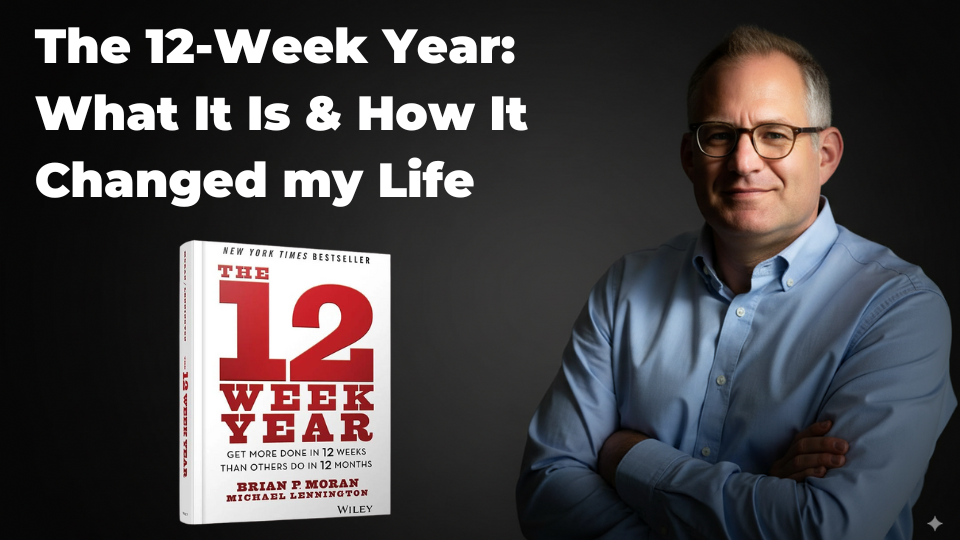
Sept. 17th, 2025


Written by Dan Mintz, a leading productivity strategist and the founder of the 12-Week Breakthrough Program. Wharton MBA, MIT Data Scientist, 3x Entrepreneur. Worked with dozens of people to transform their lives in 12 weeks.
Every January, I repeated the same ritual. I’d buy a beautifully designed planner, map out color-coded goals, and build a fresh spreadsheet. I convinced myself that this would finally be the year. The year I’d publish consistently, launch a product, get my health in order, and protect my time.
By February, the excitement had already started to fade. Everyone was busy, but I was producing very little. By June, I was skimming productivity blogs with a knot in my stomach, convincing myself I’d “start fresh in Q3.” By December, I had a gallery of plans and a handful of results—some decent, most unfinished.
The truth? I was busy without making meaningful progress. I consumed smart ideas—books, podcasts, newsletters—and mistook that for achievement. I measured inputs (pages read, courses completed) while ignoring outputs (articles published, features shipped, sales made). My vision documents looked impressive, but my weeks were chaotic. And the longer the timeframe, the easier it was to hide behind the illusion of progress.
The turning point wasn’t a New Year’s resolution. It was an ordinary Tuesday night in June. I pulled out my “Game Plan for the Year” and asked myself: What have I actually shipped that moves the needle? The answer was embarrassing. My list of completed outputs was tiny compared to all the things I’d been “working on.”
I felt frustration, shame, and a quiet fear that maybe I wasn’t capable of being consistent. That night, I tried something radically simple. I stopped thinking in years. I declared the next 12 weeks my “year.”
I chose one primary goal and one supporting goal. I blocked five deep-work sessions on my calendar (mornings only, phone in another room). I created a one-page scorecard to track lead measures I controlled. And I scheduled a 15-minute Weekly Accountability Meeting (WAM) every Friday.
Twelve weeks later, everything looked different. I had published more consistently than ever, built a lean MVP, and fixed key parts of my life that had been draining me. But the real win wasn’t just the output—it was the rhythm. I no longer negotiated with myself each morning. I simply executed the plan. That’s why I now put my full weight behind the 12 Week Year.
The 12 Week Year, created by Brian Moran and Michael Lennington, is a goal and execution system that treats every 12 weeks like a year. Instead of spreading your vision across 12 months—where urgency fades and procrastination creeps in—you compress the horizon to 12 weeks.
Here’s how it works in practice:
Clarify your vision — Define who you’re becoming and what matters most.
Set 1–2 12-week goals — Keep them realistic, specific, and measurable.
Plan weekly MITs (Most Important Tasks) — Break goals into actionable steps.
Track lead measures — Measure the inputs you control, not just the outcomes.
Hold Weekly Accountability Meetings (WAMs) — Review progress and adjust in real time.
Reset in Week 13 — Reflect, reset, and restart with renewed energy.
It’s not a gimmick. It’s a system that creates urgency, builds momentum, and forces you to focus on what actually matters.
Annual planning feels logical, but it’s built to fail. I know because I lived it for years. Here’s why:
Built-in procrastination — With 12 months, “I’ll start later” sounds reasonable. Days slip into weeks before you even notice, and drift takes over.
Weak cause-and-effect — Reviewing goals once a quarter or once a year makes it impossible to link specific actions to results. Bad habits survive undetected.
Motivation decay — Humans thrive on short-term wins. If the reward is months away, your brain diverts energy back to short-term distractions.
Consumption disguised as progress — Annual horizons justify staying in “preparation mode”: more reading, more research, more planning, fewer results.
When I shifted to 12 weeks, all of my excuses still existed—but they had nowhere to hide.

The genius of the system is in its design. It creates momentum without pushing you into unsustainable hustle.
Time compression → urgency
Twelve weeks is short enough to feel pressure, but long enough to achieve something meaningful.
Weekly rhythm → focus
You no longer wing it. You plan a small set of MITs each week and protect time blocks to execute them.
Closed loop → accountability
Scorecards and weekly check-ins force you to face reality. And Week 13 clears the slate—guilt turns into clarity.
This isn’t about working 24/7. It’s about consistent execution on the things that matter.
Keep it simple and visible. Your vision should fit on one page and answer three things:
Identity: Who am I becoming in the next 1–3 years? (“I am a consistent creator.”)
Outcomes: What will success look like at the end of this cycle?
Values and constraints: What will I protect (health, relationships) and what will I refuse to sacrifice?
I keep mine everywhere—on my desk, my phone lock screen, even my notebook cover—so my weekly actions always tie back to it.
Pick one primary goal and, at most, one supporting goal. If it can’t be completed in 12 weeks, slice it smaller.
Examples:
Publish 12 articles.
Launch an MVP and secure 10 beta users.
Run a 5K under 30 minutes.
Collect 8 client case studies.
Hold 3 strategic career conversations and deliver one signature project.
In my first cycle, my main goal was publishing weekly. Only after proving I could sustain that rhythm did I move my MVP forward.
Translate your goals into 3–5 MITs each week. Then block time to complete them. Example for publishing:
Mon: Research & outline (45–60 minutes)
Thurs: Publish (30 minutes) + repurpose (30 minutes)
Fri: Audience growth task (30 minutes)
Protect mornings if possible. Keep your phone out of reach. And if a block gets bumped, reschedule immediately—never to “someday.”
Focus on the actions you control.
Lead measures: Minutes writing, drafts completed, workouts done, outreach emails sent.
Lag measures: Income, page views, weight, followers.
I keep a one-page scorecard and aim for 85–100% weekly completion. If I drop below 70% for two weeks, I reduce scope until I regain consistency.
Every week, spend 15–30 minutes answering four questions:
Score: What % of lead actions did I complete?
Diagnosis: What worked? What didn’t? Where did I hide in “busy work”?
Decision: What will I adjust—schedule, scope, or approach?
Commitment: What are my MITs and time blocks for next week?
I’ve done these solo and with partners. Both work—the key is consistency.
At the end of the cycle, review your scorecard and results. Keep what worked, cut what didn’t, and reset with fresh energy.
This reset is powerful. Instead of carrying guilt for 12 months, you get four chances a year to recalibrate. My first Week-13 felt like a clean slate. I wasn’t weighed down by what I hadn’t done—I was energized by what I had learned.

Emotion: Ideas pile up, drafts languish, guilt grows.
12-week goals: 12 publishable works; 300 subscribers.
Weekly MITs: 5 creation blocks; Thursday publish; 1 list growth task.
Leads: Minutes writing, drafts completed, articles shipped, growth task done.
WAM: Friday check-in.
Identity shift: From “I’m learning” → “I ship.”
Emotion: Needed by everyone, but uninspired by the work.
12-week goals: Deliver 1 critical project; schedule 6 strategic 1:1s.
Weekly MITs: 3 deep-work sessions; 1 stakeholder check-in; 1 visibility artifact.
Leads: Deep-work hours, artifacts completed, 1:1s held.
WAM: Monday standup; Thursday demo.
Identity shift: From “busy” → “impactful.”
Emotion: Fitness streaks in January, slumps by February.
12-week goals: 36 workouts; 12 meal plans; 12K daily steps.
Weekly MITs: Schedule workouts; plan meals Sunday; daily walk.
Leads: Workouts completed, plans made, steps taken.
WAM: Sunday check-in.
Identity shift: From “streaks and slumps” → “consistent and well.”
The system is grounded in proven research:
Parkinson’s Law: Work expands to fill the time allowed. Shorter deadlines cut procrastination.
Goal Setting Theory (Locke & Latham): Specific, time-bound goals improve performance.
Gail Matthews Study: Writing goals and sharing weekly updates increases success by 76%.
Lean Startup Principle: Short feedback loops accelerate learning.
Self-Determination Theory (Deci & Ryan): Creation builds fulfillment through competence, autonomy, and relatedness.
Put simply: it works because it matches how humans actually focus, stay motivated, and grow.
Setting too many goals → diluted focus.
Tracking only lag measures → frustration.
Skipping weekly planning → drift.
Ignoring WAMs → no accountability.
Chasing perfection → progress beats perfection every time.
The 12 Week Year isn’t just about doing more. It reshapes how you see yourself.
Confidence grows as small wins stack up.
Adaptability improves through regular reflection.
Fulfillment increases when you create more than you consume.
Alignment happens when daily actions connect directly to your vision.
This system doesn’t just change your results. It changes your identity.
Annual goals invite delay. The 12 Week Year demands execution. It turns vague resolutions into concrete, measurable actions.
Every 12 weeks becomes a new year—with new goals, new focus, and new momentum. If you’ve been stuck in “someday” goals, this system can break you free. Don’t wait for January. Start now. Pick one meaningful goal, commit to 12 weeks, track your actions, and experience the difference.
Freedom isn’t found in waiting. It’s built 12 weeks at a time.
The 12 Week Year is a system that replaces annual planning with 12-week execution cycles. Each 12 weeks is treated like a year: you set clear goals, break them into weekly tasks, measure progress, and reset after the cycle.
Annual goals feel too far away, so urgency fades and procrastination takes over. The 12 Week Year compresses time so you act now, not “someday.” You get four chances a year to reset instead of one, which keeps momentum alive.
Most systems give you tools (like habit trackers or to-do apps). The 12 Week Year gives you a complete operating rhythm: vision, execution, accountability, and reflection. It connects long-term vision to daily action in a way annual systems rarely do.
Write a one-page vision (who you want to become, what you want to achieve).
Choose 1–2 specific goals you can realistically achieve in 12 weeks.
Break them into 3–5 weekly Most Important Tasks (MITs).
Block time in your calendar to work on those MITs.
Track lead indicators (actions you control).
Hold a short Weekly Accountability Meeting (WAM).
Reflect and reset in Week 13.
Yes. By compressing timelines and forcing weekly accountability, you stop drifting and start executing. Studies show that shorter deadlines, written goals, and accountability significantly increase success rates.
Procrastination thrives on long deadlines. With 12 weeks, the clock is always ticking. Weekly scorecards and accountability meetings create real-time pressure to act. You can’t delay for months—you only have days.
It works for:
Entrepreneurs growing a business.
Professionals advancing their careers.
Students balancing studies and self-development.
Creatives producing art, writing, or content.
Anyone tired of setting goals “for someday” and never following through.
Yes. Teams can align around shared 12-week goals, use weekly scorecards to measure progress, and hold regular check-ins. It creates clarity, urgency, and accountability across the whole group.
One primary goal and, at most, one supporting goal. More than that dilutes your focus. If a goal feels too big, slice it into a smaller 12-week milestone.
Don’t try to “catch up” with an extreme week. Simply return to the cadence, reflect on why you missed, and adjust. The goal is consistency, not perfection.
Most people thrive with 60–90 minutes. If you’re new to deep work, start with 45 minutes and build up. The key is to protect the time from distractions.
Week 13 is for reflection and reset. You review your scorecard, celebrate wins, analyze obstacles, and set new goals. It prevents burnout by giving you four clean restarts every year.
Atomic Habits is about building consistent habits through small actions. The 12 Week Year is about executing bigger goals through short cycles. They complement each other—habits give you consistency, while the 12 Week Year gives you structure and urgency.
OKRs are popular in companies for aligning teams around objectives. The 12 Week Year is more personal and execution-focused. It ensures you do the work weekly, not just set targets. You can even combine both: use OKRs for direction, 12 Week Year for execution.
Yes, but pick one primary goal (work, business, or life) with one supporting goal. Add a couple of maintenance habits (like workouts or family time) to protect your foundation. Don’t overload the cycle.
Setting too many goals.
Tracking only lag measures (like revenue or weight).
Skipping weekly planning.
Ignoring accountability.
Chasing perfection instead of progress.
Yes. Motivation fades when results are too far away. The 12 Week Year creates quick feedback loops—every week you can see progress on your scorecard, which fuels motivation to keep going.
Absolutely. In fact, the 12 Week Year works best when you’re busy. Start tiny: one meaningful goal, three focus blocks a week, one weekly check-in. Small systems done consistently beat big systems abandoned.
Yes. Consistency changes how you see yourself. Instead of being “someone who tries,” you become “someone who executes.” That shift in identity is often more powerful than the results themselves.
It’s not just more productivity. It’s freedom:
Financial freedom from creating value consistently.
Time freedom by focusing on what matters most.
Creative freedom by producing instead of just consuming.
And most importantly—trust in yourself to follow through.

Dan Mintz is the creator of the 12 Week Breakthrough Program. He advised dozens of individuals on how to achieve their most ambitious goals and reach their full potential.
Dan can be reached at:
dan.mintz@12week-breakthrough.com
About Dan Mintz
Additional Links:
Join the Program
Our Blog Page
https://12week-breakthrough.com/12-week-system-vs-productivity-hacks/
12 Week Year Implementation Guide 2026
Getting Things Done vs the 12 Week Year
Ahcieve Your Most Ambitious Goals with the 12-Week Year
Why 12 Weeks vs 12 Months?